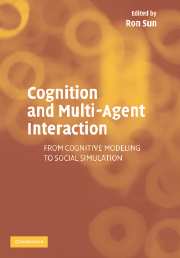Book contents
- Frontmatter
- Contents
- List of Contributors
- Preface
- PART 1 INTRODUCTION
- PART 2 OVERVIEWS OF COGNITIVE ARCHITECTURES
- PART 3 MODELING AND SIMULATING COGNITIVE AND SOCIAL PROCESSES
- PART 4 A SYMPOSIUM
- 15 Cognitive Science and Good Social Science
- 16 Collective Cognition and Emergence in Multi-Agent Systems
- 17 Social Judgment in Multi-Agent Systems
- 18 Including Human Variability in a Cognitive Architecture to Improve Team Simulation
- 19 When Does Social Simulation Need Cognitive Models?
- Index
16 - Collective Cognition and Emergence in Multi-Agent Systems
Published online by Cambridge University Press: 15 December 2009
- Frontmatter
- Contents
- List of Contributors
- Preface
- PART 1 INTRODUCTION
- PART 2 OVERVIEWS OF COGNITIVE ARCHITECTURES
- PART 3 MODELING AND SIMULATING COGNITIVE AND SOCIAL PROCESSES
- PART 4 A SYMPOSIUM
- 15 Cognitive Science and Good Social Science
- 16 Collective Cognition and Emergence in Multi-Agent Systems
- 17 Social Judgment in Multi-Agent Systems
- 18 Including Human Variability in a Cognitive Architecture to Improve Team Simulation
- 19 When Does Social Simulation Need Cognitive Models?
- Index
Summary
INTRODUCTION
In the last few decades, the study of collective cognition has become an increasingly interdisciplinary area of research, weaving together an array of scientific contributions from a wide variety of scholarly fields including social psychology, organisation science, complex adaptive systems, social network analysis, business studies, cognitive science, computer science and philosophy of mind (e.g. Argote, 1999; Carley & Hill, 2001; Harrison & Carroll, 2001; Hutchins, 1995; Resnick et al., 1993). The fundamental idea underpinning most of these studies is that cognition is a socialphenomenon that takes place and evolves in a reality jointly constructed by agents who interact within a network of social relations. To capture this idea, several “group mind”-like constructs have been introduced that extend to the group level a range of cognitive phenomena traditionally considered as belonging to the realm of the individual agent's mind (e.g. Halpern & Moses, 1990; Wegner, 1995). Such notions as mutual beliefs, transactive memory, joint intentions, joint goals and joint commitments are relatively recent developments intended to convey the idea that cognition extends beyond, and does not reduce to, the individual's mind.
However, despite the apparent enthusiasm for the subject, a number of important foundational issues still remain to be addressed. One of these (see Chapter 1 of this volume) is concerned with the nature of the relation connecting the two levels – individual and collective – at which cognition occurs within a multi-agent system (MAS). What is puzzling about this relation is the fact that one level – the collective – is determined by, and depends on, the other – the individual – and yet takes on an autonomous existence. It is the objective of this chapter to make this seemingly untenable combination of dependence and autonomy more intelligible.
Information
- Type
- Chapter
- Information
- Cognition and Multi-Agent InteractionFrom Cognitive Modeling to Social Simulation, pp. 401 - 408Publisher: Cambridge University PressPrint publication year: 2005
Accessibility standard: Unknown
Why this information is here
This section outlines the accessibility features of this content - including support for screen readers, full keyboard navigation and high-contrast display options. This may not be relevant for you.Accessibility Information
- 1
- Cited by
